I and the Bird #31
 Fall's in the air, and the birds are moving. Move your own self to migrateblog for this week's delightful edition of I and The Bird. Mariya's treated us to haikus!
Fall's in the air, and the birds are moving. Move your own self to migrateblog for this week's delightful edition of I and The Bird. Mariya's treated us to haikus!
tidbits about birds, birders and birding from WildBird's editor
 Fall's in the air, and the birds are moving. Move your own self to migrateblog for this week's delightful edition of I and The Bird. Mariya's treated us to haikus!
Fall's in the air, and the birds are moving. Move your own self to migrateblog for this week's delightful edition of I and The Bird. Mariya's treated us to haikus!
 American Bird Conservancy just released a multi-state review that looks at the impact of outdoor domestic cats on birds.
American Bird Conservancy just released a multi-state review that looks at the impact of outdoor domestic cats on birds.This report reviews cat predation impacts on rare birds in the states of New York, New Jersey, Florida, California, and Hawaii, reviews government-authorized programs and ordinances affecting feral and free-ranging cats and their management, and makes recommendations on better ways to manage cat overpopulation problems.The review looks at species such as Piping Plover, Common Tern, Florida Scrub-Jay, California Clapper Rail, Wedge-tailed Shearwater and numerous Hawaiian endemics.
Every penny of your donation will go directly to Go Zero Travel, the first program of its kind in the nation.
A contribution of just $10 offsets an average trip including air travel, a one-night hotel stay, and rental car for one person.
$25 negates air travel, four-night hotel stay, and rental car for two people.
$40 equalizes the effects of air travel, four-night hotel stay, and rental car for four people.
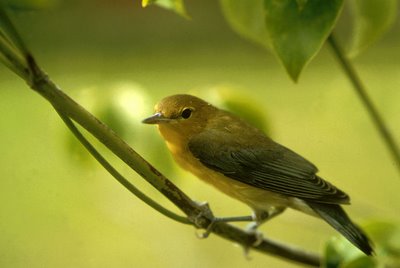 A national wildlife refuge in Louisiana will receive the first grove of trees. Bogue Chitto NWR provides habitat for Prothonotary Warblers, Swainson's Warblers, Yellow-billed Cuckoos and White-eyed Vireos among other wildlife.
A national wildlife refuge in Louisiana will receive the first grove of trees. Bogue Chitto NWR provides habitat for Prothonotary Warblers, Swainson's Warblers, Yellow-billed Cuckoos and White-eyed Vireos among other wildlife. The U.S. Department of the Interior and the Department of Agriculture said none of the more than 13,000 wild birds tested for highly pathogenic avian influenza H5N1 carried the virus.
The U.S. Department of the Interior and the Department of Agriculture said none of the more than 13,000 wild birds tested for highly pathogenic avian influenza H5N1 carried the virus.The national wild bird surveillance and early detection plan is part of President Bush’s National Strategy for Pandemic Influenza. The President allocated $29 million in his fiscal year 2006 avian influenza supplemental funding package for implementation of the wild bird monitoring plan.(Look at the size of that state!)
The U.S. Department of Interior (DOI), USDA, the State of Alaska, and the University of Alaska have been involved with sampling wild birds in Alaska since April 2006. The sampling program includes a goal to sample and test 75,000 to 100,000 migratory birds across the United States this year.
So far DOI (including the U.S. Fish and Wildlife Service and the U.S. Geological Survey) has tested more than 11,000 samples and USDA has tested more than 2,000 samples—for a total of more than 13,000. Of those tested by DOI, approximately 113 have tested positive for some form of avian influenza. This is to be expected since there are 144 subtypes of "bird flu," most of which pose no threat to domestic poultry or humans and do not produce noticeable symptoms in wild birds. Of the 113 samples, all tested negative for the highly pathogenic H5N1 virus.
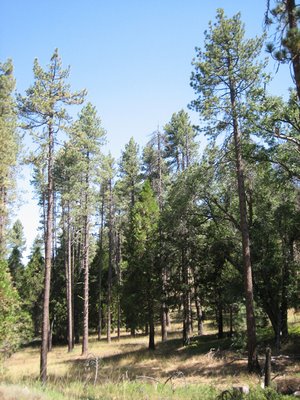 Walking down the road of crumbling asphalt, we heard and saw Steller's Jays, Acorn Woodpeckers and Pygmy Nuthatches. After making a right onto a dirt road, a House Wren crossed our path, as did a Spotted Towhee. Amid the trees, a Western Wood-Pewee vaguely reminded me of the Black Phoebes that visit my back yard. Mountain Chickadees gleaned insects seemingly everywhere.
Walking down the road of crumbling asphalt, we heard and saw Steller's Jays, Acorn Woodpeckers and Pygmy Nuthatches. After making a right onto a dirt road, a House Wren crossed our path, as did a Spotted Towhee. Amid the trees, a Western Wood-Pewee vaguely reminded me of the Black Phoebes that visit my back yard. Mountain Chickadees gleaned insects seemingly everywhere.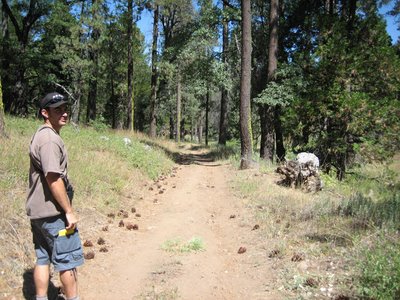 In the trees to our left, a male Painted Redstart suddenly appeared before flying across the road. The red on his belly looked beautiful! John had hoped to see an immature -- verification of successful breeding by an adult pair that he'd previously observed.
In the trees to our left, a male Painted Redstart suddenly appeared before flying across the road. The red on his belly looked beautiful! John had hoped to see an immature -- verification of successful breeding by an adult pair that he'd previously observed.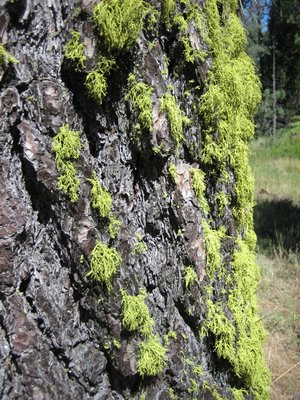 Almost as cool is the chance to look at nature up close, like this stuff. Moss? Lichen? Bueller? Bueller?
Almost as cool is the chance to look at nature up close, like this stuff. Moss? Lichen? Bueller? Bueller? The USDA National Veterinary Services Laboratories (NVSL) confirmed the presence of the "North American strain" of low pathogenic H5N1 avian influenza in one of twenty samples collected from the two wild mute swans. Preliminary test results announced on August 14 indicated that an H5N1 strain could be present in two of the collected samples.
Only one of the samples contained high enough levels of the virus to conduct confirmatory testing. As previously announced, genetic testing ruled out the possibility that either of the samples carried the highly pathogenic strain of H5N1 avian influenza that is circulating overseas.
 Then check out the National HPAI Early Detection Data System. The HEDDS site shows in which states wild birds have been tested for avian flu, how many birds have been tested and if the H5N1 virus has been detected in the samples.
Then check out the National HPAI Early Detection Data System. The HEDDS site shows in which states wild birds have been tested for avian flu, how many birds have been tested and if the H5N1 virus has been detected in the samples.Sampling has begun in many of the lower 48 states and will continue as birds begin migrating south from their northern nesting grounds. Data from three of the wild bird surveillance plan’s five strategies for early detection of HPAI are now viewable on HEDDS: sample numbers from (1) live wild birds tested, (2) subsistence hunter-killed birds, and (3) investigations of sick and dead wild birds. The other two strategies are: (4) surveillance of domestic birds as sentinel species; and (5) environmental sampling of water and wild bird droppings.
The researchers looked at 170 bird species classified as critically endangered in 1994, and 73 others that would have been classified as critically endangered had more information been available at the time. Of these, they believe 16 would very probably have gone extinct without conservation efforts.Among the cited species: California Condor, of which there were only nine in 1994. The population now numbers 128.
They also named 10 species which had been saved from extinction before 1994, and five species which are now believed to exist only in captivity. "We attempted to judge from the intensity and impact of the measures used, and from the trend in population, what would have happened had the threats not been mitigated," said lead researcher Stuart Butchart, at Cambridge-based BirdLife International, a global partnership of national conservation organisations, including the RSPB. "In none of the cases were [the populations] naturally bouncing back."
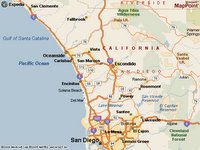 My car arrived at Julian's one four-way intersection about 7:10 a.m. The town appeared devoid of humans. Then a man appeared with a broomstick and a dustpan in hand, sweeping up the sidewalks and parking spots.
My car arrived at Julian's one four-way intersection about 7:10 a.m. The town appeared devoid of humans. Then a man appeared with a broomstick and a dustpan in hand, sweeping up the sidewalks and parking spots. John uttered his magic phrase, and then an owl called. It lured us further into the woods, seeming to move away and prompting us to billygoat on the slopes of a gully.
John uttered his magic phrase, and then an owl called. It lured us further into the woods, seeming to move away and prompting us to billygoat on the slopes of a gully.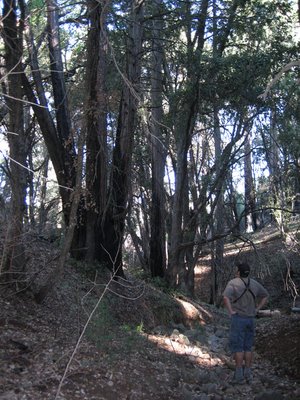 What a good-looking bird, even from the rear. I loved its plumage pattern. The fluffy, chubby owl had big yellow feet, the feet appearing more vibrant than the pale, thin slash of a beak. John estimated that the owl was a juvenile, which would explain why its call sounded more raspy than like a whistle.
What a good-looking bird, even from the rear. I loved its plumage pattern. The fluffy, chubby owl had big yellow feet, the feet appearing more vibrant than the pale, thin slash of a beak. John estimated that the owl was a juvenile, which would explain why its call sounded more raspy than like a whistle. The owl's body shape reminded me of that childhood game where you press your cheeks forward with the heels of your hands and say, "Hi. My name is Chubba." When I demonstrated it for John, he looked at me like I was a freak. OK, moving on...
The owl's body shape reminded me of that childhood game where you press your cheeks forward with the heels of your hands and say, "Hi. My name is Chubba." When I demonstrated it for John, he looked at me like I was a freak. OK, moving on... Birders around the country can talk to federal representatives about cooperative conservation and environmental partnerships at upcoming "listening sessions."
Birders around the country can talk to federal representatives about cooperative conservation and environmental partnerships at upcoming "listening sessions."The listening sessions will give citizens an opportunity to exchange ideas on incentives, partnership programs, and regulations that can improve results and promote cooperative conservation and environmental partnerships.Here's a complete list of the sessions currently on the calendar:
The meetings are the latest in a series of discussions the Administration has hosted since the President’s Conference on Cooperative Conservation in August 2005. The conference identified three broad approaches to improving conservation results: promoting cooperation within the federal government, promoting cooperation between the federal government and others, and eliminating barriers to cooperation in existing policy. Some aspects of these ideas are reflected in a recently released summary of new legislation. Other aspects will be explored in the listening sessions announced today.
 In Missouri, the U.S. Army Corps of Engineers plans to dredge Lewis and Clark Lake, creating sandbars that might provide habitat for species such as Least Tern and Piping Plover.
In Missouri, the U.S. Army Corps of Engineers plans to dredge Lewis and Clark Lake, creating sandbars that might provide habitat for species such as Least Tern and Piping Plover.“The neatest thing, particularly for this project, is the multiple benefits... We are providing habitat for wildlife; we are redirecting sediment and sand, and you have the improved navigation through the lake. If we are successful, we will look at doing more of that.”Have you had any experience -- good or bad -- with local experiments like this one?
 Mention the name Kenn Kaufman, and most birders' ears perk up. Just about everyone who's been birding at least a year or two has heard of the Kingbird Highway author, who's produced field guides about birds, butterflies, mammals and insects as well as other books. The naturalist also sketches, photographs, serves on WildBird's Advisory Board and speaks about birds.
Mention the name Kenn Kaufman, and most birders' ears perk up. Just about everyone who's been birding at least a year or two has heard of the Kingbird Highway author, who's produced field guides about birds, butterflies, mammals and insects as well as other books. The naturalist also sketches, photographs, serves on WildBird's Advisory Board and speaks about birds. Right now, my wife, Kim, is coordinating a project (through the Black Swamp Bird Observatory) whereby people can donate copies of the Spanish bird guide, at cost, and they'll go straight to educational programs in Florida, the Southwest or northern Mexico. We don't make a penny on these, but we've gotten terrific feedback from people who have been able to use the books.
Right now, my wife, Kim, is coordinating a project (through the Black Swamp Bird Observatory) whereby people can donate copies of the Spanish bird guide, at cost, and they'll go straight to educational programs in Florida, the Southwest or northern Mexico. We don't make a penny on these, but we've gotten terrific feedback from people who have been able to use the books.  The hunting and fishing communities understand about paying to support the resource, and birders could learn a lot from them. As a basic first step, all birders should buy the Duck Stamp -- it's a tremendously effective program that has provided for the protection of huge amounts of quality bird habitat.
The hunting and fishing communities understand about paying to support the resource, and birders could learn a lot from them. As a basic first step, all birders should buy the Duck Stamp -- it's a tremendously effective program that has provided for the protection of huge amounts of quality bird habitat. Now I seem to recall a movie Al Gore made – I forget what was it called – was it “An Incompetent Sooth!”? Anyway, it sure tried hard to say that Global Warming caused Katrina, and the other big storms last year, and that we were going to be having a lot more of them from now on.After reading the article, want to share your thoughts?
Most responsible scientists would say that just as this year’s hurricane activity doesn’t prove Global Warming is a fiction, last year’s didn’t prove that it is a fact. But none of those scientists got parts in that Al Gore movie, or got pubished on the front page of any big newspapers, or interviewed on TV networks news, either. That’s no doubt why most of you think that Katrina “proved” Global Warming was real – because you were meant to.
 supercilium uploaded this Least Sandpiper to the Field Guide: Birds of the World group.
supercilium uploaded this Least Sandpiper to the Field Guide: Birds of the World group. jvverde shared this Common Moorhen in Flickr's Field Guide: Birds of the World group.
jvverde shared this Common Moorhen in Flickr's Field Guide: Birds of the World group. woodcreeper digiscoped this Hooded Warbler during the World Series of Birding in New Jersey in mid-May.
woodcreeper digiscoped this Hooded Warbler during the World Series of Birding in New Jersey in mid-May.
Fledging Birders is the practice of creatively exposing people to the art of birdwatching.Please take a minute to respond to Dave's survey.
You should help prospective birders learn about birds on their own terms. It is important not to force it upon them. Instead, give them opportunities to have positive experience with birds. It's also very effective to make connections between their own lives and the world of birds. When they're ready to fly with it, they will!
 I wonder how many passengers on Antarctica cruises like this one considered themselves birders when they booked the trip. I wonder if the nonbirding passengers become interested in the birds at home after seeing all the penguins (like these Gentoo Penguins) during the cruise. I wonder if trips like this increase the number of birders. Idle wonderings...
I wonder how many passengers on Antarctica cruises like this one considered themselves birders when they booked the trip. I wonder if the nonbirding passengers become interested in the birds at home after seeing all the penguins (like these Gentoo Penguins) during the cruise. I wonder if trips like this increase the number of birders. Idle wonderings...
They were cold, wet and hungry when wildlife experts carried them into the International Bird Rescue Research Center in June, not far from where they were discovered among scores of dead birds that washed ashore in Long Beach.The state Department of Fish and Game continues to investigate the cause behind the Elegant and Caspian Terns' deaths, and rehabilitators banded and marked the nine juvenile Elegant Terns with fluorescent green dye to track them. Twelve Caspian Terns also will be released this week.
On Monday, after six weeks of feeding and exercise at the facility in San Pedro, the nine surviving terns, now plump with feathers, took flight after their release at Cabrillo Beach.
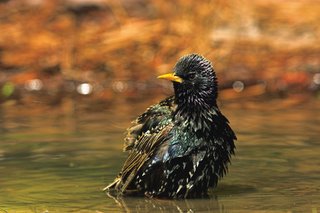 For your viewing pleasure, here's a Flickr set of the 2006 photo-contest winners. Enjoy!
For your viewing pleasure, here's a Flickr set of the 2006 photo-contest winners. Enjoy!"The magazine does not accept unsolicited manuscripts and photo submissions. Please send a detailed query that proposes your story idea or asks if we have a need for the particular photographs that you would like to submit."and this:
"We do NOT want stories about a weekend visit to a top birding area. We would rather have someone intimately familiar with the region ... to write the article."and this:
Many writers expect final review of the edited version of their manuscripts – a standard practice at many birding and ornithological journals. WildBird does not follow that practice.Close scrutiny of the guidelines can help you discern if you and the magazine/editor are a good fit for a satisfying transaction. Always keep in mind that this is a business transaction.
The morning sunshine felt good on Jane's shoulders as she walked toward the lake. She couldn't wait to see which avian treasures the water would hold today. At this early hour, she hadn't encountered any hikers who might disturb the birds that drew her to her favorite spot above the water.So, when you're done guffawing or giggling, please craft a better tale than this snippet... or maybe use this as fodder, rewrite bits and add an ending! Remember: 500 words, Sept. 6.
Ahead, Jane saw the green-blue color of her destination. A smile grew on her face, and her feet stepped more quickly. Despite the harness, her binocular began to bounce a bit more.
As she reached the bluff, Jane sighed with contentment. She had the spot to herself and could look for birds without interruptions.
"You know I can't smile without you..."
Jane spun around. Where was that voice coming from? She looked over the bluff and spotted something in the lake.
"...I can't smile without you. I can't laugh..."
Raising her bin to her eyes, Jane saw the swimming singer. Oh! Of all the days for someone to visit her favorite site. She might as well leave if she couldn't watch the birds in solitude.
"...and I can't sing. I'm finding it hard to do anything..."
Wait, maybe she wouldn't mind watching him for a few seconds. He was treading water and offering a view of his tan, wide shoulders. Not a bad view at all, Jane thought.
What was that on his left shoulder blade? A tattoo... of a bird? With her 10-power bin, Jane briefly looked at his ink before thinking "Swallow-tailed Kite in flight. What's the story behind that?"
The bin still at her eyes, Jane stepped forward. Suddenly, the earth gave way. She yelped as her feet slipped out from under her and she tumbled toward the water.
Pigeons wearing tiny backpacks and cellphones will roam the skies of Northern California this weekend as part of an unusual art project.Another launch in Irvine is scheduled for Aug. 18. If you go, please share pics or tales!
Equipped with miniature smog sensors, the birds will transmit air pollution data to a "pigeon blog" website.
...
The featherweight gadgetry fits inside a spandex backpack originally designed by a Colorado river-rafting company that employs pigeons to carry rolls of film back to civilization during wilderness tours.
Each smog-sniffing backpack weighs less than a 10th of a pigeon's body weight and costs $250, Da Costa said. Measurements of carbon monoxide and nitrogen oxide are relayed to Earth via pigeon cellphone and posted at pigeonblog.mapyourcity.net.
The king rail is not the only unusual bird that has found a home at B.K. Leach CA recently. Bird enthusiasts also have spotted stately sandhill cranes, elegant Mississippi kites, little blue herons, common moorhens (also with chicks), least bitterns, marbled godwits, marsh and sedge wrens and western meadowlarks. In the past few years, the area also has hosted glossy ibis and black-necked stilts.
 King Rail courtesy of U.S. Fish & Wildlife Service
King Rail courtesy of U.S. Fish & Wildlife Service

Duke Energy, the U.S. Fish and Wildlife Service, Patoka River National Wildlife Refuge and an array of other governmental agencies and private partners dedicated the Cane Ridge Wildlife Area on Tuesday. The area, located just outside Gibson Generating Station, has in just two years become home to one of the largest colonies of nesting Interior Least Terns.Read it all. This is precisely the kind of collaboration that needs to take place in Southern California to prevent another tern tragedy. Will SoCal birders make it happen? Paging Los Angeles Audubon!
...
Listed as an endangered species, the interior least tern gave the energy company problems due to the tern's fondness for the power plant's rocky areas for nesting and rearing young. Disruptions in the plant's operations would occur, making the least tern nests something to deal with.
In 1997 a piece of property just outside the plant was up for sale and through a creative partnership, the land was purchased and restored in hopes of attracting this small bird away from the power plant.
The plan worked.
Hi Amy:Let's look at the errors.
Please find my query on birding locations in [one area] and [another area] attached. Drop me a line with any questions. Thanks.
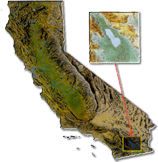 The e-mail met my eyes on Monday morning -- something about Blue-footed Boobies at Salton Sea and an invitation to join the excursion. I had to accept, given the company, the bird and the location... and, yes, the chance to get away from the computer during business hours.
The e-mail met my eyes on Monday morning -- something about Blue-footed Boobies at Salton Sea and an invitation to join the excursion. I had to accept, given the company, the bird and the location... and, yes, the chance to get away from the computer during business hours.



 Perry says his mom gave him a binocular when he was four or five: "She wanted me to aquaint myself with the gentle wonders of nature--in this case, a blue jay repeatedly mugging chickadees on the bird feeder out in the front lawn. I was fascinated by how the binoculars drew the birds in and charged them with life, how I culd see the fluff of each feather and the murderous gleam in the blue jay's right eyeball."
Perry says his mom gave him a binocular when he was four or five: "She wanted me to aquaint myself with the gentle wonders of nature--in this case, a blue jay repeatedly mugging chickadees on the bird feeder out in the front lawn. I was fascinated by how the binoculars drew the birds in and charged them with life, how I culd see the fluff of each feather and the murderous gleam in the blue jay's right eyeball." Inspired by BirdChick's recent contests, I'd like to offer a different version: Pinpoint my current age.
Inspired by BirdChick's recent contests, I'd like to offer a different version: Pinpoint my current age. 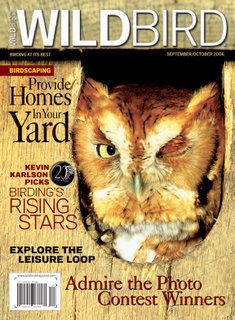 If the writer had looked at a recent issue, he/she would've seen that the nameplate on the front cover says WILDBIRD. One word. There's no "magazine" at the top of the front cover.
If the writer had looked at a recent issue, he/she would've seen that the nameplate on the front cover says WILDBIRD. One word. There's no "magazine" at the top of the front cover.A team of researchers from the University of Maryland and NASA Goddard Space Flight Center are mapping out areas of habitat suitable for the ivory-billed woodpecker, the largest and most regal member of the woodpecker family, which may still survive some 60 years after it was thought to have gone extinct.
The team just completed two weeks of flights over delta regions of the lower Mississippi River using an aircraft carrying NASA's Laser Vegetation Imaging Sensor, which has a unique ability to peer into dense forests to reveal the internal structure of the vegetation, as well as information about the terrain beneath the forest canopy. They are now working to analyze the data taken during the flights and translate it into maps of canopy cover, biomass and other measures of forest structure that will be used to identify areas where ivory-billed woodpeckers are most likely to be found.
 Time for a virtual vacation with Leigh serving as activities director! Don't forget to bring snacks and beverages; we've got a ways to travel.
Time for a virtual vacation with Leigh serving as activities director! Don't forget to bring snacks and beverages; we've got a ways to travel.
Birding by bike serves two purposes: It covers more ground than walking, but it still allows birders to hear and see a myriad of birds they’d never see by car, and access remote spots where traffic never goes.Do you know of a local club that organizes bike rides for birders?
“We’re going to stop and look at anything along the way,” Boucher assured his group, which included newcomers and seasoned bike birders. With a spotting scope and a number of bird books loaded onto his bike, he led the pack as they made their way slowly through Avery Park, toward the Willamette River boat landing on Crystal Lake Drive.